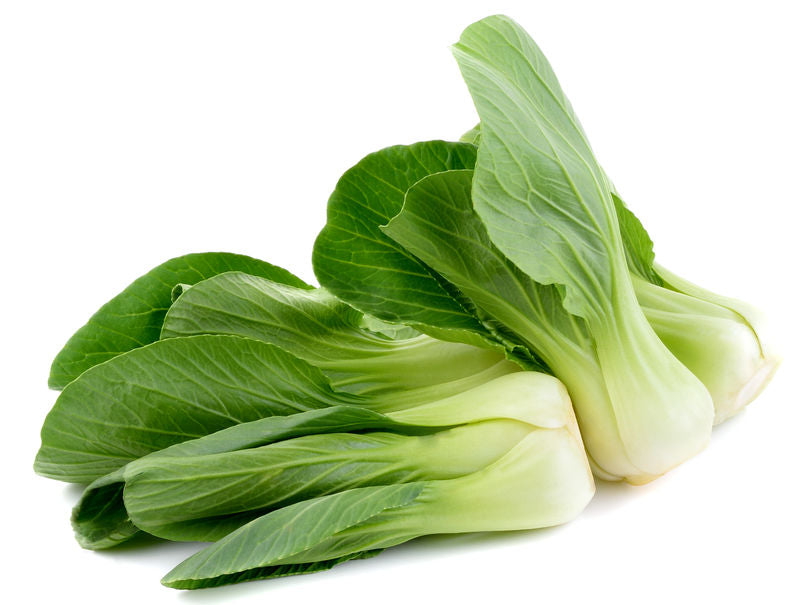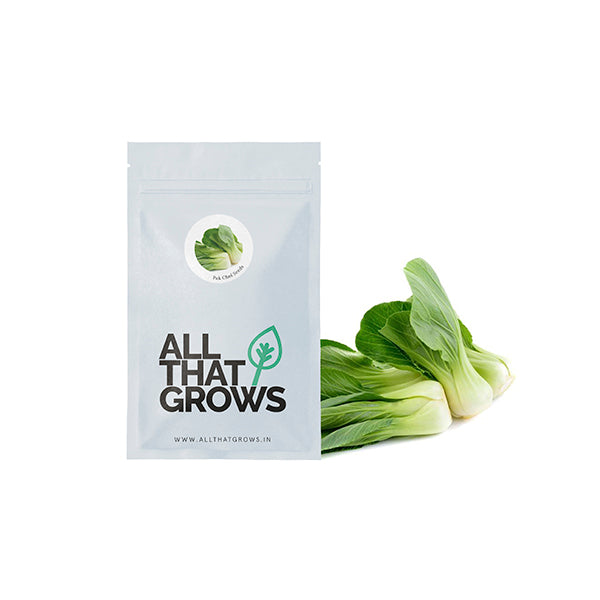



Pak Choi Seeds
Grow this with
Seed Type : Non-Hybrid, Open Pollinated and Non-GMO
Plant Height : Grows Up To 12 Inches 18 High
Flower Shape : Frilly leaves that open outward when matured
Leaf Colour : Clump of dark green leaves atop white spoon-shaped upright stems
Specification : Great addition to stir-frys, soups, braised dishes
- SOWING
TIMEAugust to November
- Sowing
Distance12-15 inches line to line, 3-4 inches plant to plant
- Fruit
WeightN/A
- Fruit
ShapeN/A
- Days to
maturity55 to 75 days
- Details
- How to sow
- Reviews
Pak Choi(Brassica rapa var. Chinensis), also known as, Pok Choy or Bok Choy, is being cultivated for over 5000 years. A staple in many traditional Asian cuisines, Pak Choi has a very unique flavor making it particularly great in soups, stir-frys and can even be consumed raw. Pak Choi hails from the Brassicaceae family of mustard greens and is remarkably juicy with hints of mustard. The white stalks of the plant join the spatula-shaped and broad green leaves together. Pak Choi is easy and quick to grow green with all edible parts. For its versatility, Pak Choi is really popular in Japan, Malaysia, Indonesia, and the Philippines. On the nutritional profile, Pak Choi is again high in the ranks. Being a rich source of Vitamins A, B6, C and K and Folate, Calcium, Magnesium, Potassium, Manganese and Iron, Pak Choi is very helpful in the detoxifying body of harmful compounds, improving bone health & blood pressure, reducing chronic inflammation & boosting immunity.
Planting instructions
Pak Choi grows well in a slightly colder season and like other brassicas. Sow the seeds ½ inch deep directly in containers or garden beds at a distance of 3 to 4 inches. Sow the seeds in moderately moist soil at a specified distance. Wider distance between each plant will be ideal for a full-size plant of Pak Choi. Keep the plant well watered to avoid bolting. Best plants to plant pak choi next to are Marigold, Nasturtium, Rhubarb, Sage, Dill, Chamomile, Coriander, and Lettuce.
Growing Requirements
pests
Flea beetle, powdery mildew, cabbage loopers, and cabbage worms are some common pests that can damage your pak choi plants by leaves small holes and brown leaves. Keep the soil properly moist to help the crop outgrow these pests. In addition to this, bolting can also be detrimental to your pak choi plants.
soil
For growing pak choi, use well-drained & crumbly soil. Avoid soil that can promote clogging and can damage plant roots. Pak Choi prefers neutral to slightly alkaline soil with ideal pH ranging between 6 to 7.5.
spot
Pak Choi grows well in full sun and can even tolerate part shade. The rule of thumb to follow is to provide more sun in really cool climates and provide more shade in hot climate areas.
temperature
The optimum temperature to grow Pak Choi is 13 to 24°C(55 to 75°F).
watering
Pak choi plant prefers slightly moist soil. Hence it is important to never let the soil dry out. Regular watering and maintaining moisture level is paramount for the successful growth of the pak choi plant. Avoid wetting the foliage and water at the base of the plant.
how to harvest
Pak Choi can be harvested when the leaves are mature. Leaves can be picked form a number of plants instead of harvesting the whole plant. The buds and flowers of the plant are edible along with the stem. Cut the stems at soil level and use outer leaves first. You can use pak choi in a number of recipes of your choice including soups, salads, stir fry's, braised recipes or can even consume it raw after washing.

Customer Reviews
The productiveness of any seed we sell is subject to your local climatic conditions*, the sowing method you adopt, and your commitment to the planting process. We give no warranty, expressed or implied, and are in no way responsible for the produce.
Please note that all our seasonal recommendations/ sowing information is as per the local climatic conditions. *For more information on the optimum conditions required for growing seeds in your region, please contact us at, hello@allthatgrows.in or Whatsapp us at, +91 8544865077
Questions & Answers
Have a Question?
Be the first to ask a question about this.




Pak Choi Seeds
Seed Type : Non-Hybrid, Open Pollinated and Non-GMO
Plant Height : Grows Up To 12 Inches 18 High
Flower Shape : Frilly leaves that open outward when matured
Leaf Colour : Clump of dark green leaves atop white spoon-shaped upright stems
Specification : Great addition to stir-frys, soups, braised dishes
Grow this with
Pak Choi(Brassica rapa var. Chinensis), also known as, Pok Choy or Bok Choy, is being cultivated for over 5000 years. A staple in many traditional Asian cuisines, Pak Choi has a very unique flavor making it particularly great in soups, stir-frys and can even be consumed raw. Pak Choi hails from the Brassicaceae family of mustard greens and is remarkably juicy with hints of mustard. The white stalks of the plant join the spatula-shaped and broad green leaves together. Pak Choi is easy and quick to grow green with all edible parts. For its versatility, Pak Choi is really popular in Japan, Malaysia, Indonesia, and the Philippines. On the nutritional profile, Pak Choi is again high in the ranks. Being a rich source of Vitamins A, B6, C and K and Folate, Calcium, Magnesium, Potassium, Manganese and Iron, Pak Choi is very helpful in the detoxifying body of harmful compounds, improving bone health & blood pressure, reducing chronic inflammation & boosting immunity.
Seed Type : Non-Hybrid, Open Pollinated and Non-GMO
Plant Height : Grows Up To 12 Inches 18 High
Flower Shape : Frilly leaves that open outward when matured
Leaf Colour : Clump of dark green leaves atop white spoon-shaped upright stems
Specification : Great addition to stir-frys, soups, braised dishes
- SOWING
TIMEAugust to November
- Sowing
Distance12-15 inches line to line, 3-4 inches plant to plant
- Fruit
WeightN/A
- Fruit
ShapeN/A
- Days to
maturity55 to 75 days
Planting instructions
Pak Choi grows well in a slightly colder season and like other brassicas. Sow the seeds ½ inch deep directly in containers or garden beds at a distance of 3 to 4 inches. Sow the seeds in moderately moist soil at a specified distance. Wider distance between each plant will be ideal for a full-size plant of Pak Choi. Keep the plant well watered to avoid bolting. Best plants to plant pak choi next to are Marigold, Nasturtium, Rhubarb, Sage, Dill, Chamomile, Coriander, and Lettuce.
Growing Requirements
pests
Flea beetle, powdery mildew, cabbage loopers, and cabbage worms are some common pests that can damage your pak choi plants by leaves small holes and brown leaves. Keep the soil properly moist to help the crop outgrow these pests. In addition to this, bolting can also be detrimental to your pak choi plants.
soil
For growing pak choi, use well-drained & crumbly soil. Avoid soil that can promote clogging and can damage plant roots. Pak Choi prefers neutral to slightly alkaline soil with ideal pH ranging between 6 to 7.5.
spot
Pak Choi grows well in full sun and can even tolerate part shade. The rule of thumb to follow is to provide more sun in really cool climates and provide more shade in hot climate areas.
temperature
The optimum temperature to grow Pak Choi is 13 to 24°C(55 to 75°F).
watering
Pak choi plant prefers slightly moist soil. Hence it is important to never let the soil dry out. Regular watering and maintaining moisture level is paramount for the successful growth of the pak choi plant. Avoid wetting the foliage and water at the base of the plant.
how to harvest
Pak Choi can be harvested when the leaves are mature. Leaves can be picked form a number of plants instead of harvesting the whole plant. The buds and flowers of the plant are edible along with the stem. Cut the stems at soil level and use outer leaves first. You can use pak choi in a number of recipes of your choice including soups, salads, stir fry's, braised recipes or can even consume it raw after washing.



 Sign In
Sign In








